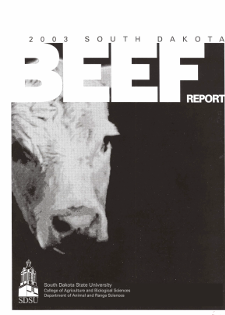Document Type
Report
Report Number
2003-15
Publication Date
2003
Keywords
steers, water, performance, sulfate, polioencephalomalacia
Summary
Water available to livestock in western South Dakota is often high in total dissolved solids (TDS) and sulfates. Eighty-one crossbred, yearling steers (700 lb) were used to determine the effects of TDS and/or sulfates in water on cattle performance and health. Cattle were stratified by weight and randomly assigned to one of 12 pens (6-7 steers/pen). Pens were randomly assigned to one of four treatments (three pens/treatment) based on supplied water: 1) rural water (RW; 1,019 ppm TDS; 404 ppm sulfates, 2) well water (WW; 4,835 ppm TDS; 3,087 ppm sulfates), 3) dam water (DW; 6,191 ppm TDS; 3,947 ppm sulfates), and 4) DW early switched to 10,000 ppm TDS water mid-summer (DWS). The DWS treatment was not achieved due to less than predicted TDS in dam water late in the summer, resulting in six pens in the DW treatment (three treatments). Dam water was transported from a local stock dam, and well water was pumped from a well on the research station. From June 20 to September 12, steers were fed a diet of grass hay and wheat middlings (NEg = 0.38 to 0.42 Mcal/lb), and the respective water was hauled into each pen. Water intake was lower (P < 0.10) for steers supplied WW (10.9 gallons/d) and DW (11.1 gallons/d) than for steers supplied RW (12.6 gallons/d). Steers supplied RW had higher DMI (P < 0.10) and gain/feed (P < 0.05) than steers supplied WW or DW. Steers supplied RW also had higher ADG (P < 0.05) than steers on WW or DW (1.38, 1.02, and 1.02 lb/day for RW, WW and DW, respectively). The incidence of polioencephalomalacia (PEM) was 15 and 12.5% for WW and DW, respectively, compared to no cases in RW (P < 0.10). Three steers died of PEM (one from WW and two from DW). Dietary sulfur concentrations were 0.27, 0.74, and 0.93% of dry matter for RW, WW and DW, respectively. It is unclear whether sulfur alone caused the reductions in performance or if other factors associated with TDS were important. Performance and health did not decline as TDS and sulfates increased above that in the WW treatment, indicating a threshold was achieved. Increased TDS and/or sulfates in the water reduced performance and health of growing steers.
Number of Pages
4
Format
application/pdf
Language
en
Publisher
South Dakota State University
Rights
Copyright © 2003 South Dakota State University
Recommended Citation
Patterson, Hubert H.; Johnson, Patricia S.; Young, Doug B.; and Haigh, Ronald, "Effects of Water Quality on Performance and Health of Growing Steers" (2003). South Dakota Beef Report, 2003. 16.
https://openprairie.sdstate.edu/sd_beefreport_2003/16

